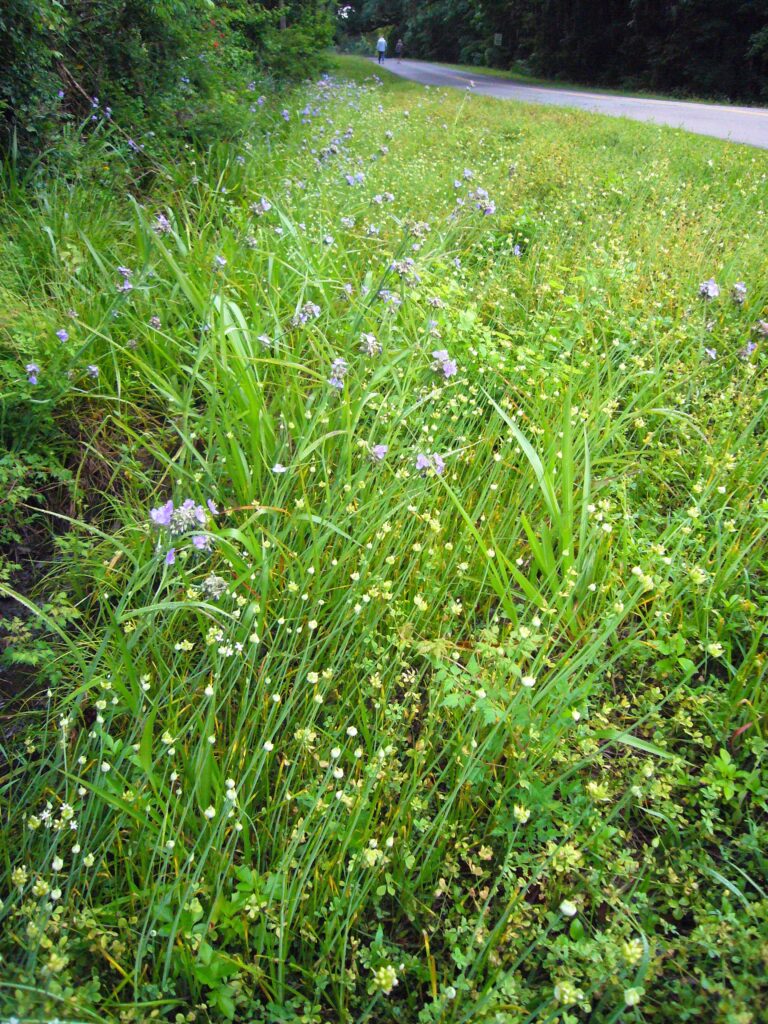
Allium canadense also called Meadow Garlic, the blue blossoms are spiderwort (also edible.) Photo by Green Deane
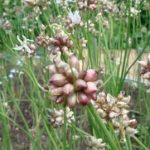
Wild Garlic usually cloves in April making it easier to spot. Photo by Green Deane
It’s April and locally that means wild garlic month. Allium canadense, starts its annual cycle in December. For several months is looks like grass with a small onion bulb. Then approaching April it puts three or more cloves on top making it quite distinct. One does not find this species often but when you do it is usually prolific. We marveled over them last week during a foraging class at Eagle Lake in Largo. They can be found in several locations near Gainesville, and a few east of Orlando. Email me if you want more specific locations. (GreenDeane@gmail.com)
The cloves can be used like commercial garlic (as can the rest of the plant.) Or they can be used like seeds to grow more garlic. The species like sunny damp spots (roadside ditches is a favored location.) The onion bulb on the bottom end is often about six inches deep in the soil. Further north in the South there is allium carolinianum which is actually native to Uzbekistan, Kazakhstan, western China, and Mongolia not the carolinas. It is far taller around two feet and has smaller cloves. It is also a prime example of why plant name’s can or cannot be changed. As it is native to western Asia and not the Carolinanas, the specie name cannot be changed because the region is wrong. There has to be a botanical reason to change a name. Pinus palustris has the same problem. Palustris means it likes to grow in swamps whereas it prefers dry soil. Just because the location is wrong the name can’t be changed. You can watch my video on wild garlic here.
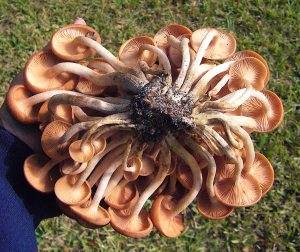
These prime Ringless Honey Mushrooms are cespitose, all growing out of one spot. Photo by Green Deane
Maybe it’s about time to make a prediction. Locally we had several inches of chilly rain. The ground temperature has not greatly warmed up from winter, nights are still cool. It is April. Those are acceptable conditions for a spring flush of edible Ringless Honey Mushroom. They don’t do it every April but the conditions might be right this year. Ground temperature and rain directly affect fungi production. Cool rain and cool ground in April equals Ringless Honey Mushrooms. Warm rain and warm ground in May/June equals Chanterelles.
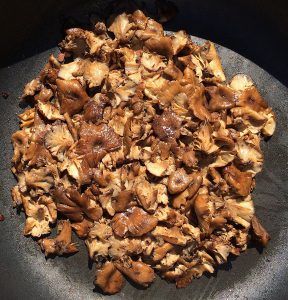
Ringless Honey Mushrooms have a good texture and taste. Photo by Green Deane
“Honeys” come with some conditions and warnings. Not all people can eat them. I know at least four folks for whom Honeys give severe gastro-intestinal distress, to put it mildly. This includes cooking them twice such as parboiling them first then frying. So the first time you try Honeys eat only a small amount. Next is method of preparation. Some people can’t eat them just fried, they have to parboil them first then fry them. I just fry them but much longer than store-bought button mushrooms. And parts…. most folks eat just young caps. They use the stems for flavoring. Honeys, in my opinion, is a good stewing mushroom. They holds its flavor and texture in a wet medium though frying the caps is my most common means of cooking them. Once they are cooked then I add other ingredients to the pan. I have a video about them here and an article.
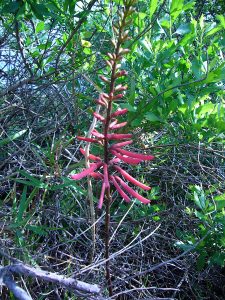
The Eastern Coral Bean is easy to spot this time of year. Photo by Green Denne
Also blossoming this time of year is the Eastern Coral Bean, sometimes called the Cherokee Bean. What is odd about this plant is the edible flowers produce toxic beans. So we do not eat the red and black beans. A few of the red blossoms are edible raw — with precautions — but they are usually boiled then mixed with other foods notably scrambled eggs. When you boil the blossoms they turn light green. The distinctive uterine shape of the leaves makes the shrub easy to identify. Young leaves are edible boiled but are marginal fare. Like Pawpaws they prefer dry, sunny places. A few raw red blossoms seem okay but if eaten in larger amounts they can be mind altering and approaching dangerous. Boiled they are fine. (Juice from the shrub’s stems, by the way, has been used to treat scorpion stings and the toxic beans have a chemical that is close in structure to the alkaloid curare which can cause breathing paralysis.) You can see my video about the species here or read more about the Eastern Coral Bean here.
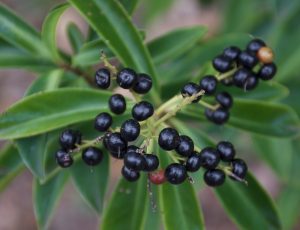
Marlberries aren’t too edible. Photo by Green Deane
Marlberries and I don’t meet too often, about once or twice a year and then usually while I’m conducting a class so I don’t have the time to get acquainted better. There is also a certain lack of motivation because even at its best marlberry is not a great trailside nibble. A complicating headache is there are several malberries of varying quality. They are also related to the invasive species Coral Berry, Ardisia crenata, which has been implicated in cattle poisoning. Reportedly found mid-Florida and south I have found Marlberries in Dreher Park in West Palm Beach, LaStrange Preserve in Ft. Pierce, and Emerson Point near Sarasota. Around the same time and in the same habitat you find Marlberries you can also see Rapanea punctata, Colicwood, one of those mystery pants one finds in wet woods this time of year. It looks like a drab cross between a mangrove and a beautyberry and used to be called Myrsine guianensis. Colicwood’s small yellow blossoms and black fruit grow directly on the branches, helping you identify it. There’s not a whole lot of literature on the species so the berries are probably not edible. As it is called “Colicwood” suggest some medicinal uses. To read more about the Marlberry and its strange relatives go here.

Foraging classes are held rain, shine, hot or cold. Photo by Nermina Krenata
Foraging classes: Steady weather prompts more foraging classes:
Saturday, April 13th, Red Bug Slough 5200 S. Beneva Road, Sarasota. 9 a.m. to noon. Meet at the parking lot.
Sunday, April 14th, Bayshore Live Oak Park, Bayshore Drive. Meet at Ganyard Road and Bayshore. 9 a.m. to noon.
Saturday, April 20th, Blanchard Park, 2451 Dean Rd, Union Park, FL 32817, meet beside the tennis courts, 9 a.m. to noon.
Sunday, April 21st, Wickham Park: 2500 Parkway Drive, Melbourne, FL, meet at the dog park. 9 a.m. to noon.
Saturday, April 27th, Mead Garden: 1500 S. Denning Dr., Winter Park, FL 32789. Meet at the bathrooms. 9 a.m. to noon.
Sunday, April 28th, Colby-Alderman Park: 1099 Massachusetts Street, Cassadaga. Fla. 32706. meet at the bathrooms, 9 a.m. to noon.
Saturday, May 4th, Eagle Park Lake, 1800 Keene Road, Largo, FL 33771. Meet at the pavilion near the dog park. 9 to noon.
Sunday, May 5th, Boulware Springs Park, 3420 SE 15th St., Gainesville, FL 32641. Meet at the picnic tables next to the pump house. 9 a.m. to noon.
For more information on these classes, to prepay or sign up go here.
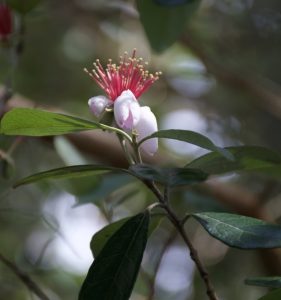
Pineapple Guava blossoms are always attractive. Photo by Green Deane
Also starting to blossom is the Pineapple guava. Perhaps no ornamental has been championed as much as the Pineapple Guava, aka Feijoa, Acca sellowiana, Feijoa sellowiana. However the perfect shrub for many places never really caught on. There could be several reasons. It probably didn’t help that the Strawberry Guava is a severe invasive species in some locations. The shrub also does not get showy. You have to hunt for the extroverted blossoms. While the entire blossom is edible most people only eat the petals. Five or six months from now they will be dark green fruit that stay green as they ripen. They just get softer. The shrub is easy to identify when in blossom. To read more about both guavas, go here.

Green Deane Forum
Want to identify a plant? The Green Dean Forum is up and running again. Have you come to dislike Facebook, then join us on the forum. Perhaps you’re looking for a foraging reference? You might have a UFO, an Unidentified Flowering Object, you want identified. On the Green Deane Forum we — including Green Deane and others from around the world — chat about foraging all year. And it’s not just about warm-weather plants or just North American flora. Many nations share common weeds so there’s a lot to talk. There’s also more than weeds. The reference section has information for foraging around the world. There are also articles on food preservation, and forgotten skills from making bows to fermenting food.

You get the USB, not the key.
172-video USB would be a good end of spring present and is now $99. My nine-DVD set of 135 videos has been phased out. The USB videos are the same videos I have on You Tube. Some people like to have their own copy. Most of the 172 USB videos have to be copied to your computer to play. If you want to order the USB go to the DVD/USB order button on the top right of this page. That will take you to an order form.
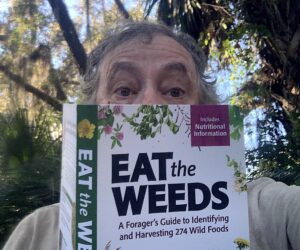
Finally, a physical copy of the book.
Now in its second printing is EatTheWeeds, the book. It has 275 plants, 367 pages, index, nutrition charts and color photos. It’s available in many locations including Amazon. Most of the entries include a nutritional profile. It can also be ordered through AdventureKeen Publishing.
This is weekly newsletter #596. If you want to subscribe to this free newsletter you can find the sign-up form in the menu at the top of the page.
To donate to the Green Deane Newsletter click here.


My colleague and I will be at the foraging class on Saturday in Sarasota. I will bring cash for the payment!